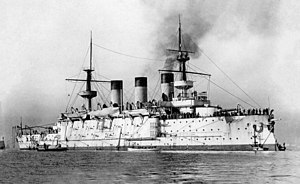 Peresvet at anchor, 1901
| |
| Class overview | |
|---|---|
| Name | Peresvet |
| Builders |
|
| Operators | |
| Preceded by | Rostislav |
| Succeeded by | Potemkin |
| Subclasses | Pobeda |
| Built | 1898–1903 |
| In commission | 1901–22 |
| Completed | 3 |
| Lost | 2 |
| Scrapped | 1 |
| General characteristics | |
| Type | Pre-dreadnought battleship |
| Displacement | 13,320–14,408 long tons (13,534–14,639 t) |
| Length | 434 ft 5 in (132.4 m) |
| Beam | 71 ft 6 in (21.8 m) |
| Draft | 26 ft 3 in (8.0 m) |
| Installed power |
|
| Propulsion | 3 shafts, 3 Vertical triple-expansion steam engines |
| Speed | 18 knots (33 km/h; 21 mph) |
| Range | 6,200 nmi (11,500 km; 7,100 mi) at 10 knots (19 km/h; 12 mph) |
| Complement | 27 officers, 744 men |
| Armament |
|
| Armor | |
The Peresvet class was a group of three pre-dreadnought battleships built for the Imperial Russian Navy around the end of the 19th century. Peresvet and Pobeda were transferred to the Pacific Squadron upon completion and based at Port Arthur from 1901 and 1903, respectively. All three ships were lost by the Russians in the Russo-Japanese War of 1904–05; Peresvet and Pobeda participated in the Battles of Port Arthur and the Yellow Sea and were sunk during the siege of Port Arthur. Oslyabya, the third ship, sailed to the Far East with the Second Pacific Squadron to relieve the Russian forces blockaded in Port Arthur and was sunk at the Battle of Tsushima with the loss of over half her crew.
Peresvet and Pobeda were salvaged after the Japanese captured Port Arthur and incorporated into the Imperial Japanese Navy. Peresvet was sold back to the Russians during World War I, as the two countries were by now allies, and sank after hitting German mines in the Mediterranean in early 1917 while Pobeda, renamed Suwo, remained instead in Japanese service and participated in the Battle of Tsingtao in late 1914. She became a gunnery training ship in 1917. The ship was disarmed in 1922 to comply with the terms of the Washington Naval Treaty and probably scrapped around that time.